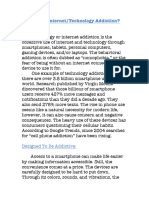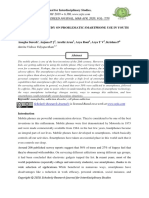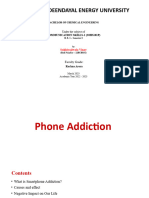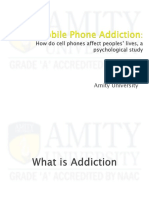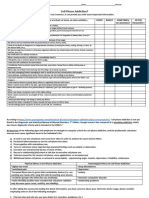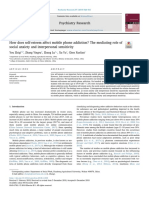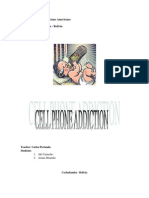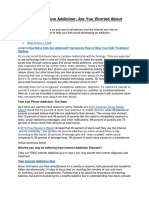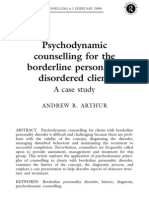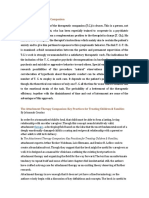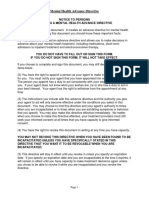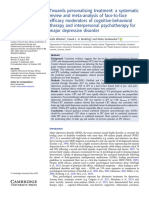References
Mobile Technology Fact Sheet. (2013, December 27). Retrieved November 30, 2015, from
http://www.pewinternet.org/fact-sheets/mobile-technology-fact-sheet/
Diagnostic and statistical manual of mental disorders: DSM-5. (5th ed.). (2013). Washington, D.C.:
American Psychiatric Association.
Singh Bhatia, M. (2008). Cell Phone Dependence — a new diagnostic entity. Delhi Psychiatry Journal,
11(2), 123-124. Retrieved November 30, 2015, from http://medind.nic.in/daa/t08/i2/daat08i2p123.pdf
Digital Eye Strain Report 2015. (2015). Retrieved November 30, 2015, from
http://www.thevisioncouncil.org/digital-eye-strain-report-2015
Hansraj, K. (2014). Assessment of Stresses in the Cervical Spine Caused by Posture and Position of the
Head. (25), 277-279. Retrieved November 30, 2015, from
http://www.ncbi.nlm.nih.gov/pubmed/25393825
Health Risks of Using Mobile Phones. (n.d.). Retrieved November 30, 2015, from
http://source.southuniversity.edu/health-risks-of-using-mobile-phones-137310.aspx
Dangers of Texting Whilst Driving. (2008). Retrieved November 30, 2015, from
http://www.trl.co.uk/case-studies/behaviour-dangers-of-texting-whilst-driving/
Deepinder, F., Makker, K., & Agarwal, A. (2007). Cell phones and male infertility: Dissecting the
relationship. Reproductive BioMedicine Online, 15(3), 266-270. Retrieved November 30, 2015, from
http://www.sciencedirect.com/science/article/pii/S1472648310603380
Patel, R. (2015, June 17). Cell Phone use before bedtime might impact sleep, and daytime tiredness.
Retrieved November 30, 2015, from https://u.osu.edu/emotionalfitness/2015/06/17/cell-phone-use-
before-bedtime-might-impact-sleep-and-daytime-tiredness/
Babadi-Akashe, Z., & Zamani, B. (2014). The Relationship between Mental Health and Addiction to
Mobile Phones among University Students of Shahrekord, Iran. Addict Health, 6(3-4), 93-99.
Andreassen, C. (2015). Online Social Network Site Addiction: A Comprehensive Review. Curr Addict Rep
Current Addiction Reports, 2015(2), 175-184. doi:10.1007/s40429-015-0056-9
Lepp, A., Li, J., Barkley, J., & Salehi-Esfahani, S. (2015). Exploring the relationships between college
students’ cell phone use, personality and leisure. Computers in Human Behavior, 43, 210-219. Retrieved
November 30, 2015, from http://www.sciencedirect.com/science/article/pii/S0747563214005822
Greenfield, D. (2013). Smartphone Abuse Test. Retrieved November 30, 2015, from http://virtual-
addiction.com/new-smartphone-abuse-test-now-online/
�References
Young, K. (2007). Cognitive Behavior Therapy with Internet Addicts: Treatment Outcomes and
Implications. CyberPsychology & Behavior, 10(5), 671-679. doi:10.1089/cpb.2007.9971
Young, K. (2013). Treatment outcomes using CBT-IA with Internet-addicted patients. Journal of
Behavioral Addictions, 2(4), 209-215. http://dx.doi.org/10.1556/JBA.2.2013.4.3
Andreassen, C. (2015). Online Social Network Site Addiction: A Comprehensive Review. Curr Addict Rep
Current Addiction Reports, 2015(2), 175-184. doi:10.1007/s40429-015-0056-9
Przepiorka, A., Blachnio, A., Miziak, B., & Czuczwar, S. (2014). Clinical approaches to treatment of
Internet addiction. Pharmacological Reports, 66(2), 187-191.
Internet & Tech Addiction Anonymous (ITAA). (n.d.). Retrieved November 30, 2015, from
http://www.netaddictionanon.org/
ReSTART Center for Technology Sustainability. (2015). Retrieved November 30, 2015, from
http://www.netaddictionrecovery.com/
Camp Grounded – Summer Camp for Adults – Digital Detox. (2014). Retrieved November 30, 2015, from
http://campgrounded.org/
References
ReSTART Center for Technology Sustainability. (2015). Retrieved November 30, 2015, from
http://www.netaddictionrecovery.com/
Camp Grounded – Summer Camp for Adults – Digital Detox. (2014). Retrieved November 30, 2015, from
http://campgrounded.org/
Hong S-B, Zalesky A, Cocchi L, Fornito A, Choi E-J, Kim H-H, et al. (2013) Decreased Functional Brain
Connectivity in Adolescents with Internet Addiction. PLoS ONE 8(2): e57831.
doi:10.1371/journal.pone.0057831
Kim, H. (2013). Exercise rehabilitation for smartphone addiction. Journal of Exercise Rehabilitation, 9(6),
500-505. doi:10.12965/jer.130080
�O’keeffe, G., & Clarke-Pearson, K. (2011). The Impact of Social Media on Children, Adolescents, and
Families. Pediatrics, 127(4), 800-804.
Teens, Social Media & Technology Overview 2015. (2015, April 8). Retrieved December 1, 2015, from
http://www.pewinternet.org/2015/04/09/teens-social-media-technology-2015/
Teen Cell Phone Addiction Treatment – Paradigm Malibu. (n.d.). Retrieved December 1, 2015, from
http://paradigmmalibu.com/teen-cell-phone-addiction-treatment/
Teen Cell Phone Addiction. (n.d.). Retrieved December 1, 2015, from http://familybootcamp.org/cell-
phone-addiction/
Diagnostic and statistical manual of mental disorders: DSM-5. (5th ed.). (2013). Washington, D.C.:
American Psychiatric Association.
Kim, Y., Park, J., Kim, S., Jung, I., Lim, Y., & Kim, J. (2010). The effects of Internet addiction on the lifestyle
and dietary behavior of Korean adolescents. Nutrition Research and Practice Nutr Res Pract, 4(1), 51-51.
doi:10.4162/nrp.2010.4.1.51
Pontes, H., Griffiths, M., & Patrao, I. (2014). Internet Addiction and Loneliness Among Children and
Adolescents in the Education Setting: An Empirical Pilot Study. Aloma, 32(1), 91-98.
Digital Eye Strain Report 2015. (2015). Retrieved November 30, 2015, from
http://www.thevisioncouncil.org/digital-eye-strain-report-2015
Hansraj, K. (2014). Assessment of Stresses in the Cervical Spine Caused by Posture and Position of the
Head. (25), 277-279. Retrieved November 30, 2015, from
http://www.ncbi.nlm.nih.gov/pubmed/25393825
Dangers of Texting Whilst Driving. (2008). Retrieved November 30, 2015, from
http://www.trl.co.uk/case-studies/behaviour-dangers-of-texting-whilst-driving/
Young Adult Development Project. (2008). Retrieved December 1, 2015, from
http://hrweb.mit.edu/worklife/youngadult/brain.html
Cheung, G (Aug 2007). “Stability of the harm avoidance personality trait in late-life depression”. Int
Psychogeriatr 19(4): 778-80. doi:10.1017/s1041610207005194
Han, D., Lee, Y., Yang, K., Kim, E., Lyoo, I., & Renshaw, P. (2007). Dopamine Genes and Reward
Dependence in Adolescents with Excessive Internet Video Game Play. Journal of Addiction Medicine,
1(3), 133-138. doi:10.1097/ADM.0b013e31811f465f
�As a library, NLM provides access to scientific literature. Inclusion in an NLM database does not imply
endorsement of, or agreement with, the contents by NLM or the National Institutes of Health.
Learn more: PMC Disclaimer | PMC Copyright Notice
Logo of addhealth
Addict Health. 2014 Summer-Autumn; 6(3-4): 93–99.
PMCID: PMC4354213PMID: 25984275
The Relationship between Mental Health and Addiction to Mobile Phones among University Students of
Shahrekord, Iran
Zahra Babadi-Akashe, MSc,1 Bibi Eshrat Zamani, PhD,2 Yasamin Abedini, PhD,3 Hojaetolah Akbari,4 and
Nasim Hedayati, PhD5
Author information Article notes Copyright and License information PMC Disclaimer
Go to:
Abstract
Background
The risk of cell phone addiction is a social and psychological problem which has been proposed by
psychologists, psychiatrists, and educational supervisors. The present study aimed to investigate the
behavior of mobile phone addicts and mental health of university students of Shahrekord, Iran.
Methods
This study was an applied research survey for the purposes of this study. The study population
ýconsisted of all the students of Payame Noor University, Islamic Azad University, and University of
Medical Sciences. The study population consisted of 296 students who were randomly selected from the
target population. To collect data, two types of questionnaires were used, the Symptom Checklist-90-
R(SCL-90-R) questionnaire, and the 32-point scale questionnaire of behavior associated with ýmobile
phone use (Hooper and Zhou, 2007). Data analysis was performed using SPSS software, statistical
analysis, frequency distribution, mean, one-way ANOVA, chi-square, and LSD (Least significance
difference).
Findings
The results showed that university students of Shahrekord, based on the six categories of mobile
ýaddiction behaviors, were mostly placed in habitual behaviors (21.49%), addiction (21.49%), and
�intentional (21.49%) categories. By reviewing mental health indicators, it was found that students were
affected with depressive disorder (17.30%), obsessive compulsive disorder (14.20%), and interpersonal
sensitivity (13.80%). The results showed that there was a significant inverse relationship ýbetween
mental health and habitual behaviors (r = -0.417), dependence (r = -0.317), addiction (r = -0.330), and
incontinence (r = -0.309) in using mobile phone (P < 0.001).
Conclusion
Survey results showed that with increased and improved mental health, the student’s rate of cell phone
addiction reduced.
Keywords: Mental health, Cell phone, Addiction, Behavior, University
Go to:
Introduction
The current era can be known as a combination of information and communication. Today, in possession
of advanced information and communication technology, we are able to establish connections and
exchange information faster than before.1 The most dominant type of information and communication
technology is the mobile phone, the use of which in the past few years, due to social impact, has grown
substantially. Mobile phone addiction, as a mental impairment resulting from modern technology, has
come to the attention of psychologists, sociologists, and scholars of education. Troubled mobile phone
use can be accounted a form of technological addiction.
Many mobile phone addicts are people with low self-esteem and poor social relationships; thus, they
think they should be in constant contact with others. Mobile phone silence can lead to anxiety,
irritability, sleep disturbances, shaking, insomnia, and digestive problems.2 From the perspective of
Thomee et al. problematic and overuse of mobile phones is associated with anxiety, insomnia,
depression, psychological distress, and unhealthy lifestyle.3 The emotional attachment to mobile
phones for their users is in a way that makes them believe they cannot live without a cell phone.
Researches have presented the negative impact of excessive use of mobile phones on physical and
mental health of students.4 Medical research on the effects of mobile phone indicates that this means
of communication does not act in order to maintain the health of its users. For example, results of a
number of studies show that mobile phone radiation causes changes in gene regulation, auditory and
visual problems, increased pressure of acid on the cornea and lens tissue, headache, heat sensation in
the ears, memory loss, and fatigue.5-9 Studies also showed that prolonged use of cell phones cause
brain tumors.10 In terms of psychology, communication technology reduces social relations and the
welfare of the individual due to loneliness, depression, and isolation. Beydokhti ýet al. found that among
�adults and young people, the use of information and communication technology can lead to social
anxiety and sleep disorders.11
From these contents it can be concluded that there is a relationship between addiction to mobile
phones and physical and psychological health. In fact mental health includes behaving in harmony with
the community, acceptance of social reality and the ability to cope with them, and satisfying one’s needs
moderatly.12 Mental health according to the World Health Organization is a health condition in which a
person knows their own abilities, can cope with the normal stresses of life, is fruitful for the community,
and is able to make decisions and collective participation. Therefore, mental health is the base for
welfare and health for individuals and society.
Hooper ýand Zhou, psychologists from Staffordshire University, studied 106 people who had used
ýmobile phones, and found that 16.00% of them have behavioral problems. Their research concluded
that behavioral problems followed by the addiction to cell phone use causes stress.12 Despite the
importance of mobile phones in everyday life, research indicated that some people use this device
uncontrollably and this has affected their personal lives.13 Review of research literature on the subject
indicated that excessive use of mobile phones is a form of technology addiction. Results of the study by
Hooper and Zhou showed that the rate of mobile phone use among university students is very high.12
There is a relatively high number of evidence for mandatory, voluntary, or dependent use of cell
ýphones; however, habitual, compulsive, and addictive behaviors of mobile phone use are relatively
ýless observed.
The findings of Shambare et al. showed that mobile phone use was mostly addictive, habitual, and
dependent.14 The study of Ahmed et al. showed that a small number, less than 18.50%, of Pakistani
students displayed mobile-related addictive behaviors. In this study the targeted subjects used mobile
phones under reasonable conditions, and thus, did not have the tendency for addictive behaviors in
mobile phone use.15 The results of several studies showed that addiction to text messages has a
relationship with students’ social anxiety and nervousness, and personality traits of extraversion and
neuroticism. Furthermore, the rate of addiction to text messages in different educational groups of
students were different.1,11,16
Moreover, other studies showed a positive correlation between depression and anxiety and the amount
of sent text messages in a day, and loss of control and social anxiety.17,18 Chen examined the
relationship between depression and mobile phone addiction on 519 American students and concluded
that there was a significant association between mobile phone addiction symptoms (distraction,
�withdrawal, and escape) and depression. In addition, he stated that women had significantly higher
rates of mobile phone addiction symptoms compared to men.19
Technology addiction in general and dependency on cell phones in particular are important for several
reasons. Despite the advantages and necessity of technologies for human society, due to their
stimulating factors, they results in excessive use and lead to addiction. Young people are more
vulnerable to excessive phone use, and thus, become phone dependent.20 Young people’s mental
health, addiction to mobile phones, as a driving force, and an active community is major topics that are
discussed in psychology and sociology. The present study addressed the question of whether there is
any relationship between the amount and type of cell phone addiction and mental health status of
university students in Shahrekord, Iran.
Go to:
Methods
Due to the purpose of this study, this research was an applied research survey. The study population
consisted of all students in different universities of Shahrekord (Islamic Azad University, Payame Noor
University, and University of Medical Sciences). From among the target population, 296 subjects were
randomly selected. Two types of questionnaires were used to collect data that include the Symptom
Checklist-90-R (SCL-90-R) questionnaire, and 32-point scale questionnaire of behavior associated with
mobile phone use (Hooper and Zhou, 2007).12 The SCL-90-R questionnaire has been used in many
researches in Iran and outside Iran, and has a high reliability.12,21-23 The validity and reliability of the
mobile phone use questionnaire in some researches was at a high level.13,19 In order to analyze the
collected data, SPSS for Windows (version 18, SPSS Inc., Chicago, IL, USA) was used. The Pearson
correlation analysis, Student’s independent t-test, and chi-square test were used for data analysis. From
the total of 296 students who participated in the study, 57.10% were men, 49.90% were female, 14.90%
were single, 85.10% were married, 34.80% were living in a dormitory, and 65.20% lived elsewhere.
Moreover, 50.30% studied in public Universities of Medical Sciences, 32.80% studied in Payame Noor
University, and 16.90% enrolled in Islamic Azad University.
Go to:
Results
Based on the results of table 1, the majority of students, according to the categories of addictive
behaviors of mobile phone, were placed in the three categories of habitual behaviors (21.49%),
voluntary behaviors (21.49%), and dependent behaviors (21.49%). Based on the results of table 2,
students, with regard to mental health, had higher rates of depression (17.30%), obsessive-compulsive
�disorder (OCD) (14.20%), and interpersonal sensitivity (13.80%). Results showed that with confidence
interval of 0.99 and P < 0.001, there was a relationship between mental health and four out of six
categories of mobile phone addiction (habitual behaviors, dependent behaviors, addictive behaviors,
and involuntary behaviors). In fact, only at the level of voluntary and compulsive behaviors there was no
significant relationship with students' mental health. The results showed that with confidence interval of
0.99 and P < 0.001, there was a significant negative relationship between mental health and general
behavior of addiction to mobile phones. This means that as the rate of mobile addiction becomes less,
the students’ mental health increases. Table 3 presented phone addictive behaviors that have a
significant relationship with mental health. Based on these results, mental health of university students
of Shahrekord did not differ according to demographic factors (gender, type of university, type of
residence, education, and marital status).
Table 1
Ranking mobile phone addiction in terms of defined behaviors (n = 296)
Description Percentage
Habitual behavior 21.49
Voluntary behavior 21.49
Dependent behavior 21.49
Involuntary behavior 16.53
Compulsive behavior 16.53
Addictive behavior 15.70
Open in a separate window
Table 2
Ranking mental health in terms of study dimensions
Description Percentage
Depression 17.30
OCD 14.20
�Interpersonal sensitivity13.80
Anxiety 11.60
Psychosis 10.88
Hypochondrias 10.46
Paranoia 10.39
Hostility 6.05
Phobias5.22
Open in a separate window
OCD: Obsessive-compulsive disorder
Table 3
The relationship between mobile phone addiction behavior and mental health
Types of addictive behaviors toward mobile phone Correlation coefficient with mental health
Habitual -0.417*
Voluntary -0.011
Dependent -0.317*
Involuntary -0.309*
Mandatory -0.060
Addictive behaviors -0.330*
General addictive behavior toward mobile phones -0.383*
Open in a separate window
*Correlation is significant at the 0.01 level (2-tailed)
Go to:
Discussion
�The results of this study showed that university students of Shahrekord, based on the six categories of
mobile phone addictive behaviors, were mostly placed in categories of habitual, voluntary, and
dependent behaviors with 20.30%. These finding were consistent with results of several studies.12,17-
20 As was noted in the findings section, there was a significant inverse relationship between mobile
phone addiction and mental health. Findings show that the highest correlation was related to mental
health and habitual behaviors. Habitual behaviors refer to behaviors that are formed from habit,
without hesitation, thought, and mental awareness in order to achieve a particular purpose.17 Students
who suffer from lower mental health, usually when faced with a challenge, a problem, or an assignment
or a specific purpose, feel helpless, frustrated, and powerless. As a result, to counteract these negative
feelings, they turn to their previous habits involuntarily and automatically, such as mobile phone
contacts, and with this they reduce their anxiety and worry due to their inefficiencies. It was observed
that after habitual behaviors, addictions and dependent behaviors have the highest negative correlation
with mental disorder. One of the most important causes of this serious relationship probably depends
on the nature of addictive and dependent behaviors. Addictive behavior refers to a sudden and
involuntary tendency to do a particular act or behavior, in the state of psychological imbalance, and the
main factors that drive this conflict and psychological imbalance are irrational negative, inner
thoughts.12,21-23 Hence, it seems that students with lower mental health and psychological balance,
are more vulnerable to addictive mobile phones use, because they try to reduce their internal tensions
by talking to others. On the other hand, students who had average and high mental health levels also
had some types of addiction to mobile phones (habitual addiction). This could be related to excessive
use of mobile phones for long-distance calls to family members. Another factor is the lack of
entertainment and addiction to entertainment and games that are available on mobile phones. Factors
such as jealousy, personality characteristics, the presence or absence of metacognitive skills such as self-
regulation skills, and financial considerations could be other factors for the usage or non-usage of cell
phones.21-23 Further research on the relationship between these factors and mobile phone addiction is
recommended.
The results showed that between mental health and addictive behaviors toward mobile phones there
was a significant inverse relationship in the categories of dependent, involuntary, and addiction
behaviors. In other words, in higher mental health, human behavior is more rational, and the amount of
cell phone addiction reduces. These findings were consistent with results from a number of studies such
as Thomee et al.,3 Chen,19 Billieux et al.,17 Park et al.,18Hassanzadeh and Rezaei,1 Golmohammadian
and Yaseminejad,24 and Seyed Ali.25 Research results indicate that there is a relationship between
addiction to mobile phone and mental health in dimensions of behavioral problems, anxiety, depression,
and psychosis. In addition, the results showed that there was no relationship between the occurrence of
behaviors of cell phone addiction and gender, type of residence, type of university, and the study filed.
These findings were consistent with results of Koo and Park,26 Pawlowska and Potembska,27 Wei,28
and Wilska,29 and domestic research, including Zamani et al.21-23 The investigation showed that there
was a relationship between mobile phone addictive behavior and gender-related factors. Furthermore,
there was a relationship between habitual behaviors of mobile phone use and marital status, addictive
�behaviors, and university. However, the results indicated that there was no significant relationship
between mental health and gender, marital status, type of residence, university, and field of study.
Conclusion
Survey results showed that with increased and improved mental health, the rates of students’ addiction
to mobile phones reduced. Hence, it is necessary to take more steps in developing recreational
programs for students’ leisure time to maintain students’ mental health, and thereby decrease addiction
to a variety of new digital media such as the Internet, chat rooms, computer games, and mobile phones.
Therefore, it is necessary that the university authorities and higher education institutions develop
training programs, and make efforts to maintain physical and mental health of students.
Go to:
Acknowledgments
We would like to thank all students in different universities of Shahrekord for their collaboration in this
research.
Go to:
Footnotes
Conflicts of Interest
The Authors have no conflict of interest.
Go to:
REFERENCES
1. Hassanzadeh R, Rezaei A. Pathology of using Information and communication technologies by
universities' students. Information and Communication Technology in Educational Sciences.
2010;1(1):79–91. [Google Scholar]
2. Hassanzadeh R, Rezaei A. Effect of sex, course and age on SMS addiction in students. Middle-East
Journal of Scientific Research. 2011;10(5):619–5. [Google Scholar]
�3. Thomee S, Harenstam A, Hagberg M. Mobile phone use and stress, sleep disturbances, and symptoms
of depression among young adults--a prospective cohort study. BMC Public Health. 2011;11:66. [PMC
free article] [PubMed] [Google Scholar]
4. Igarashi T, Motoyoshi T, Takai J, Yoshida T. No mobile, no life: Self-perception and text-message
dependency among Japanese high school students. Computers in Human Behavior. 2008;24(5):2311–24.
[Google Scholar]
5. Zhao TY, Zou SP, Knapp PE. Exposure to cell phone radiation up-regulates apoptosis genes in primary
cultures of neurons and astrocytes. Neurosci Lett. 2007;412(1):34–8. [PMC free article] [PubMed]
[Google Scholar]
6. Meo SA, Al-Drees AM. Mobile phone related-hazards and subjective hearing and vision symptoms in
the Saudi population. Int J Occup Med Environ Health. 2005;18(1):53–7. [PubMed] [Google Scholar]
7. Balci M, Devrim E, Durak I. Effects of mobile phones on oxidant/antioxidant balance in cornea and
lens of rats. Curr Eye Res. 2007;32(1):21–5. [PubMed] [Google Scholar]
8. Hocking B, Westerman R. Neurological effects of radiofrequency radiation. Occup Med (Lond)
2003;53(2):123–7. [PubMed] [Google Scholar]
9. Kosmanis TI, Kosmidou EP, Zygiridis TT, Kantartzis NV, Xenos TD, Tsiboukis TD. A comparative study of
the biological effects of various mobile phone and wireless LAN antennas. Magnetics, IEEE Transactions.
2002;38(2):777–80. [Google Scholar]
10. Mild KH, Hardell L, Carlberg M. Pooled analysis of two Swedish case-control studies on the use of
mobile and cordless telephones and the risk of brain tumors diagnosed during 1997-2003. Int J Occup
Saf Ergon. 2007;13(1):63–71. [PubMed] [Google Scholar]
















